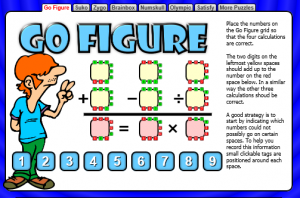Sign In | Starter Of The Day | Tablesmaster | Fun Maths | Maths Map | Topics | More
In a break with tradition I am going to choose a puzzle of the month that I have already used as the monthly puzzle a couple of years ago. The reason is that two weeks ago I heard the most wonderful new solution to the puzzle that I’m sure you will appreciate so let’s start with the puzzle:
Three people enjoyed a meal at a restaurant. The waiter brings the bill for £30 so each person pays £10. Later the chef realises that the bill should have only been £25 so he sends the waiter back to the table with five pound coins. The waiter could not figure out how to divide the £5 so he gave each person a £1 and kept £2 for himself.
So....the three people have paid nine pounds each for the meal: 3 x £9 = £27
The waiter kept two pounds: £27 + £2 = £29
What happened to the other pound?
The new answer will be at the bottom of this newsletter but before that here are some of the new resources added to the website this last month.

Go Figure is a number placing puzzle in which interconnected addition, subtraction. multiplication and division calculations have to be completed using the digits one to nine.
I got quite excited when I saw pupils using this activity for the first time and heard them talk about their insights. The puzzle can be used to introduce a new problem-solving strategy for this kind of task. Rather than concentrate on which digits could go in the available spaces, make a list of the digits that could not possibly go into the spaces. You really need to try this yourself to see how the properties of the four rules are analysed in the puzzle solving thinking. Make sure you click the 'Show Tags' button to assist you find the solution.
Olympic Rings was put together to coincide with the Winter Olympics but the relevance of the puzzle will live on during this inter-Olympic time. There are three levels of difficulty with the lower levels being made easier with some pre-placed digits. This makes the puzzle accessible to younger children but also provides a starting point for an advanced level proof investigation.
Map Scales came about because, after being asked for a good exercise on ratios as used in map scales, I couldn’t find one! There are two levels and the second level introduces the tricky and not necessarily intuitive notion of area scale factors.
Barmy BIDMAS Is a new advanced Lesson Starter. You will need to know about the order of operations and factorial notation to appreciate the subtly of this mathematical wonder. Students could be challenged to make a similar calculation with the surprising value of 6!
Time Sort is the latest additions to the 'Telling the Time' collection. There are three levels including digital times, analogue clocks and phrases to represent times. Try using it with pupils working in pairs and listen to the discussion generated.
Sum to One is a set of decimal numbers on virtual cards which can be used for a matching activity. A pairs game, a multiple choice quiz, a tug-of-war game and a snap game. Is that too much choice?
The book I am reading at the moment is Craig Barton’s new book How I Wish I'd Taught Maths: Lessons learned from research, conversations with experts, and 12 years of mistakes. I am a great fan of Craig’s podcasts (I listen to them on my Tuesday morning cycle ride) and this book collects together the insights Craig has collected from all of the educational experts he has interviewed. At the time of writing, 93% of the reviewers on Amazon had awarded the book five out of five stars. I thoroughly recommend this book to you here.
Thanks to those of you who have posted photographs on Twitter of the Transum activities being used in the classroom. It is so good to see that the work that went in to producing the resources was worthwhile. Thanks
If you follow me on Twitter (@Transum) you may have noticed that my list of 'Hidden Gems on the Transum Website' has been growing from the 19 included in the last newsletter. I think I will stop when I get to 50.
Now let’s continue the search for the missing pound from the puzzle of the month. One hour later two elderly ladies came into the restaurant and enjoyed a meal together. The waiter brings the bill for £30 so each lady pays £15. The chef again tells the waiter that the bill should have only been £25 so he sends the waiter back to the table with five pound coins. The waiter could not figure out how to divide the £5 so he gave each lady a £1 and kept £3 for himself.
So....the two ladies have paid fourteen pounds each for the meal: 2 x £14 = £28
The waiter kept three pounds: £28 + £3 = £31
So there is the missing pound! Genius isn’t it? I heard this solution on the Danny Baker radio show and have included the audio excerpt towards the bottom of the June 19th Starter of the Day. It’s worth listening to. Enjoy.
All the best for the month ahead
John
P.S. Always wear glasses to Maths lessons. They help with division!
Do you have any comments? It is always useful to receive feedback on this newsletter and the resources on this website so that they can be made even more useful for those learning Mathematics anywhere in the world. Click here to enter your comments.
Did you know you can follow this newsletter on Substack completely free of charge? Please note this is separate from a paid subscription to the Transum website, which unlocks a much wider range of premium resources.